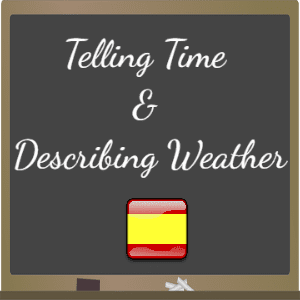Telling time and describing the weather are fundamental language skills in any language. In this lesson, we cover the different ways of telling time and describing the weather in Spanish.
Telling the Time in Spanish
In Spanish, the verb “ser” (to be) is used in the third-person forms to describe time.
The singular form “es” is used for “one o’clock,” while other hours (from two to twelve o’clock) use the plural form “son.”
| Es la una. | It’s one o’clock. |
| Son las tres. | It’s three o’clock. |
| Son las once. | It’s eleven o’clock. |
To ask what time it is, use the expression: “¿Qué hora es?” meaning “What time is it?” in English, or more literally: “What hour is it?” To ask “At what time …?”, we use “¿A qué hora … ?”
Expressing Minutes
To express time in hours and minutes, we use the conjunction “y” (and) or “con” (with).
| Es la una y treinta. Es la una con treinta. | It’s one-thirty. |
| Son las cinco y veinticuatro. Son las cinco con veinticuatro. | It’s five twenty-four. |
If you want to say it is minutes to a certain hour, e.g., “It’s five to ten,” use “menos” (minus).
| Es la una menos diez. | It’s ten to one. |
| Son las diez menos cinco. | It’s five to ten. |
An alternative way is to use “para.” Either “es” or “son” can be used.
| Es un cuarto para las seis. Son un cuarto para las seis. | It’s quarter to six. |
The “15 minutes” and “30 minutes” can sometimes be replaced with “cuarto” (quarter) and “media” (half), respectively.
| Es la una menos cuarto. | It’s a quarter to one. |
| Son las cuatro y media. | It’s four-thirty. |
The expressions “a.m.” and “p.m.” are commonly used in written Spanish.
Other Time Expressions
Here are some expressions that are used to express time with examples:
| de la mañana | in the morning | It’s 9 a.m. | Son las nueve de la mañana. |
| de la tarde | in the afternoon | It’s 1 p.m. | Es la una de la tarde. |
| de la noche | in the evening at night | It’s 7 p.m. | Son las siete de la noche. |
| de la madrugada | in the wee hours | It’s 4 a.m. | Son las cuatro de la madrugada. |
| mediodía | noon | It’s noon. | Es mediodía. |
| medianoche | midnight | It’s midnight. | Es medianoche. |
| en punto | sharp | It’s two o’clock sharp. | Son las dos en punto. |
| más o menos | around | It’s around three o’clock. | Son las tres más o menos. |
Weather Expressions in Spanish
Describing the weather in Spanish often involves the use of some idiomatic expressions that make little sense if translated into English literally. For example, the expression “Hace mucho calor” translates literally to “It makes much heat.” However, it just means that it is too hot. Similarly, the expression “Hay sol,” which means that the sun is shining, makes little sense when translated literally as “There is sun.”
Here we list a few common ways of describing the weather using some of these idiomatic expressions as well as other simple expressions in Spanish.
Weather Expressions using the verb “hacer”
| ¿Qué tiempo hace? | What’s the weather like? |
| Hace buen tiempo. | The weather is good. |
| Hace mal tiempo. | The weather is bad. |
| Hace (mucho) frío. | It’s (too) cold. |
| Hace calor. | It’s hot. |
| Hace sol. | It’s sunny. |
| Hace viento. | It’s windy. |
| Hace fresco. | It’s brisk. |
Weather Expressions using the verb “hay”
The verb “hay” means “there is/are” and is used in many weather expressions.
| Hay sol. | The sun is shining. |
| Hay luna. | The moon is out. |
| Hay nubes. | It’s cloudy. |
| Hay niebla. | It’s foggy. |
| Hay neblina. | It’s misty. |
| Hay humedad. | It’s humid. |
| Hay relámpagos. | There is lightning. |
| Hay granizo. | It’s hailing. |
| Hay lloviznas. | It’s sprinkling. |
| Hay un vendaval. | There is a windstorm. |
Weather Expressions using the verb “estar”
We can also use the verb “estar” in the third-person singular form followed by an adjective to describe the weather.
| Está soleado. | It’s sunny. |
| Está nublado. | It’s cloudy. |
| Está lluvioso. | It’s rainy. |
| Está oscuro. | It’s dark. |
Weather Expressions using a simple verb
One can also use a simple verb expression in the third-person singular form, such as “llueve,” the third-person singular form of the present tense of the verb “llover” (to rain). Other examples include:
| Llueve. | It’s raining. |
| Nieva. | It’s snowing. |
| Llovizna. | It’s sprinkling. |
| Truena. | It’s thundering. |
Quiz: Telling Time & Describing the Weather in Spanish
Other lessons in Level III:
Level III – Elementary
3. The Verb “to Know”: “Saber” vs. “Conocer”
4. Indefinite Adjectives & Pronouns
7. Special Uses of “Haber” & “Tener”
8. Telling Time & Describing The Weather in Spanish
9.1. The Adverbs “Tan,” “Solo,” “También,” “Tampoco,” “Vez,” and “Veces”











